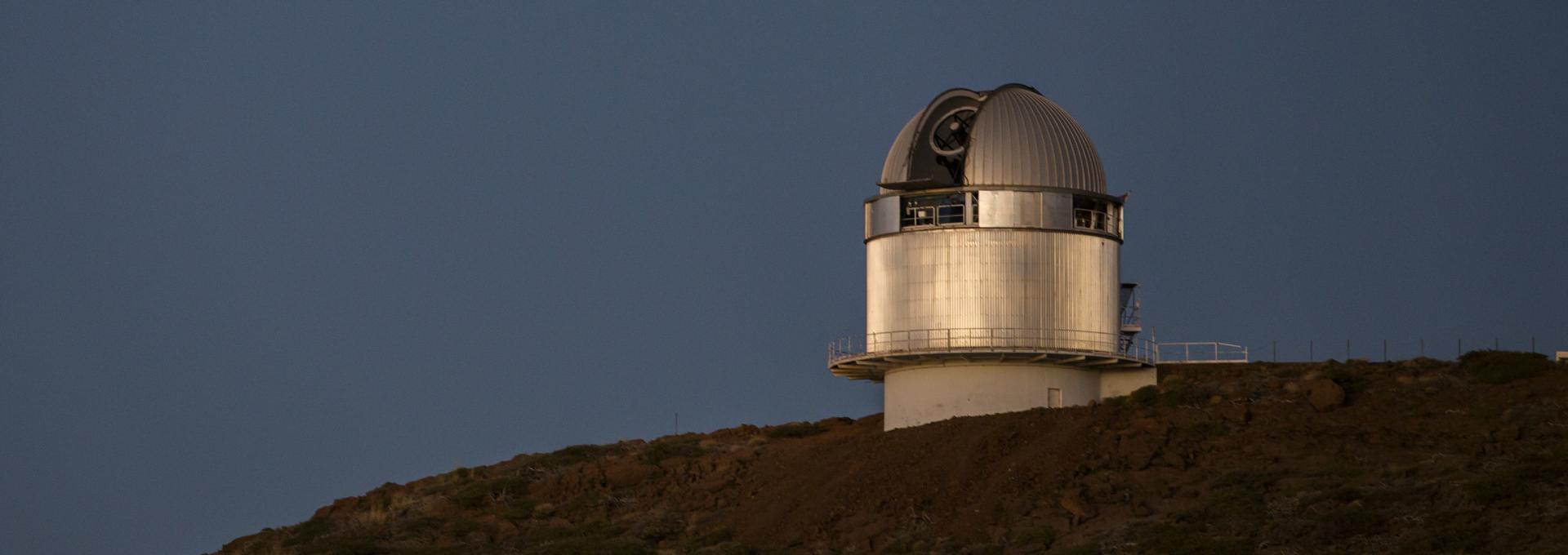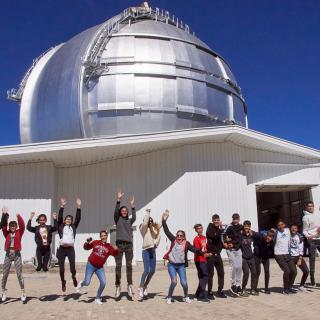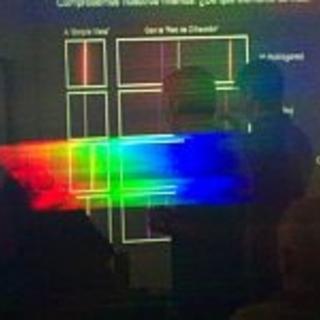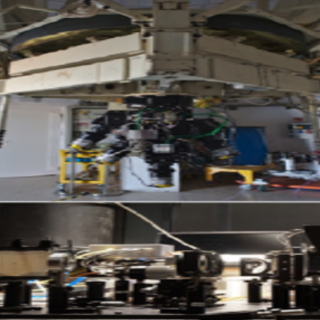Nordic Optical Telescope


El Telescopio Óptico Nórdico (NOT) es un moderno telescopio visible/infrarrojo de 2,6 m de diámetro, situado en la parte más elevada del Observatorio del Roque de los Muchachos. Inaugurado en 1989, un consorcio de Consejos de Investigación de Dinamarca, Finlandia, Noruega, Suecia y la Universidad de Islandia se encargan de dirigir NOT.
NOT está al servicio de las comunidades astronómicas de estos países, así como de España, aunque también pueden solicitar tiempo de observación con los astrónomos de otros países. Un Comité independiente evalúa todas las propuestas de observación, promoviéndose la competencia para obtener tiempo de observación.
Asimismo, NOT participa en el Programa de Acceso Trans-nacional de OPTICON para todos los astrónomos europeos, financiado por la Comisión Europea bajo el Sexto Programa Marco de Investigación y Desarrollo Tecnológico.
El espejo primario del NOT tiene un diámetro de 2,6 m. El telescopio se mueve sobre sus ejes vertical y horizontal, bajo un control absoluto por ordenador. El edificio, que es bastante ligero, rota con el telescopio mismo. NOT está diseñado para tomar imágenes de alta calidad tanto en el visible como en el infrarrojo cercano, por lo que las superficies ópticas son de alta calidad y pueden afinarse para proporcionar una respuesta óptima. El edificio está diseñado para evitar cualquier perturbación de fuentes de calor, y la cúpula se enfría durante el día. La cúpula se regula con aire ambiental al inicio de la noche por medio de unas grandes compuertas, una característica adoptada más tarde por todos los telescopios.
Debido a estas características y a su localización ideal en el observatorio, NOT proporciona de forma permanente las mejores imágenes de cualquier telescopio nocturno del ORM. En la medida de lo posible las observaciones se programan para aprovecharse de las mejores condiciones de observación.
NOT está equipado con un conjunto de instrumentos diseñados para optimizar su rendimiento en proyectos donde puede ser competitivo. La combinación de cámara visible y espectrógrafo que conforma ALFOSC ofrece un amplio y flexible conjunto de modos de observación; se puede disponer de forma simultánea de imagen directa y espectroscopía, tanto individual como multiobjeto. Un exclusivo modo de lectura de alta velocidad multi-ventana permite realizar un seguimiento de las rápidas variaciones de brillo de la estrella objeto de estudio, relacionándola con diversas estrellas de comparación medidas simultáneamente.
NOTCam es la contrapartida en el infrarrojo cercano a ALFOSC, y ambos instrumentos tienen una gran demanda para la realización de programas de observación que abarcan desde la cosmología hasta el Sistema Solar. Como complemento a ambas se tiene dos espectrógrafos échelle de alta resolución, SOFIN y FIES, ideales para trabajos detallados en objetos brillantes. FIES se alimenta mediante fibra óptica, lo que hace que esté permanentemente disponible para un amplio rango de proyectos que requieren de flexibilidad en el calendario de observaciones.
"A project to build a Nordic Telescope was first proposed in 1980 by Profs. Bengt Strömgren and Anders Reiz, who obtained funding for a feasibility study for a 2.5m telescope from the Carlsberg foundation. A feasibility study by Torben Andersen was completed in July 1981 and discussed at the Nordic Astronomy Meetings in November 1981 and February 1982. A Nordic Optical Telescope Committee was formed in September 1982 and a revised project study was presented at the end of 1982. Funding for initial project activities, notably site testing and progress on detailed design, was provided in early 1983 by the Swedish and Danish Natural Science Research Councils.
The project became reality in December 1983, when the Nordic Council of Ministers allocated 8 MSEK to the construction, upon which the four Nordic research councils (Denmark, Finland, Norway, and Sweden) approved the remaining 21 MSEK. Thus, the Nordic Optical Telescope Scientific Association (NOTSA) was founded in January 1984, and the first Council and Director (Arne Ardeberg, Lund) were appointed (Iceland joined NOTSA later, in 1997).
Substantial work started in July 1984, when a technical project group was formed, and the main design features of the NOT were approved in early 1985. At the same time, it was decided to locate the telescope at the new observatory site on La Palma. After a number of technical and financial difficulties had been overcome, the NOT was inaugurated in 1989, and regular observations started in 1990. The initial years of operation proved the excellent basic qualities of the telescope and the site but, as pointed out by an international review panel in 1994, deficiencies in the instrumentation and insufficient staff for the operations on La Palma still prevented the telescope from reaching its full potential.
Under Vilppu Piirola (Turku), who took over as Director in 1995, the budget and operations of NOTSA were thoroughly reorganised with a focus on the scientific output. An adequate scientific and technical staff on La Palma was recruited, headed by an experienced Astronomer-in-Charge, Hugo Schwarz, and an ambitious, systematic programme brought the NOT operations up to international standards. At the same time, the Associates funded a joint programme to equip the telescope with a versatile set of state-of-the-art optical and near-infrared workhorse instruments. As a result, the scientific interest in and reputation of the NOT increased steadily, as reflected in the annual lists of publications based on NOT data. A far-sighted step in this period was to join the EU-funded Infrastructure Coordination Network OPTICON, which involved the NOT - and Nordic astronomy in general - in the initiatives to promote greater synergy and coordination in European ground-based astronomy.
The NOT was thus already a well-established, successful operation in 2002, when Johannes Andersen and Thomas Augusteijn became Director and Astronomer-in-Charge (later Deputy Director). Gradual instrumentation upgrades continued (new detectors; a stable location for the high-resolution spectrograph FIES), and financial reserves also made it possible to overhaul and completely renew the telescope control and cooling systems, securing continued operation for another couple of decades. In parallel, a sustained programme was pursued to document and streamline telescope, instrument and data flow operations so as to improve the efficiency, flexibility and reliability of the operations and the short- and long-term scientific value of the data. Notable scientific results include long-term monitoring of active stars and rapid response to events in the emerging fields of Gamma-Ray Bursts and exoplanets (for more detail, see the Annual Reports and lists of publications). A programme of training activities, including an expanded Research Student programme, was also developed. At the end of September 2013 Johannes Andersen retired, and Thomas Augusteijn was appointed Director as of October 1st, 2013."
"The original concept for the NOT was an independent, general facility for observational projects by Nordic astronomers. The scientific and organisational context in which it operates today is vastly different from that of 1990: Finland has joined ESO (along with UK, Spain and several other countries), and a new generation of European (even global) mega-facilities at optical, infrared and radio wavelengths dominates the scene. Smaller telescopes, such as the NOT, must specialise and coordinate their operations at the European level in order to be scientifically and financially competitive.
This philosophy underlies the ASTRONET consortium, which was formed in 2005 by all the largest funding agencies for European astronomy, with EU support. Its goal is to prepare a science-based plan for the coordinated development of all of European astronomy - at all wavelengths, from the ground and in space, and including the crucial human resources. In extension of its membership in OPTICON, NOTSA has played a very active role in ASTRONET and contributed significantly to the development of a new operational paradigm for the European 2-4m telescopes.
Thus, we see the future of the NOT as a specialised tool in the panoply of facilities available to European astronomy, focused on scientific fields where it can optimally serve the best Nordic and European science teams, and in concert with telescopes offering complementary capabilities. To this end, we plan to equip it with a single new, permanent focal-plane instrument, offering optical and NIR imaging and spectroscopy and modelled on the highly successful X-shooter at the ESO Very Large Telescope (VLT). With FIES upgraded to yield high-precision spectropolarimetry and also permanently available, this will make the NOT a powerful tool for studying a wide range of transient and variable astrophysical sources in the coming decade."





No se ha encontrado ningún resultado.